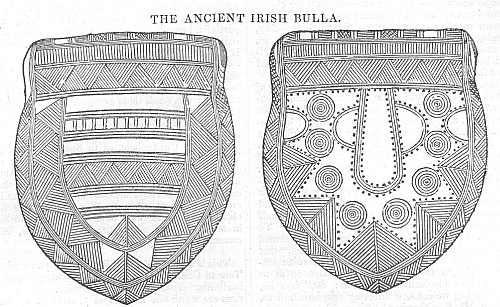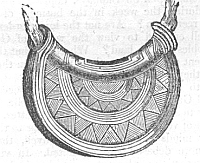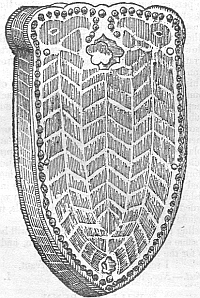The Ancient Irish Bulla
From The Dublin Penny Journal, Volume 1, Number 23, December 1, 1832.

The beautiful, unique, and hitherto unpublished specimen of the ancient Irish Bulla or amulet, of which we have prefixed engravings of the two sides, was found in the Bog of Allen nearly a century ago, and is now deposited in the valuable museum of Irish antiquities of the Dean of St. Patrick's. It is apparently of solid gold, but in reality of lead covered over with a thick plating of the finer metal; and its chased ornaments are exactly those found on the golden collars arn other Irish ornaments of the most remote antiquity found in Ireland. It is hollow to contain the charm, with holes at the top for the string to pass through by which it was suspended, and its general form is nearly that of a heart.
The Bulla has not hitherto been noticed by antiquarians as being used by the Irish; but it was probably common to all ancient nations from a very remote and unknown period, and its general use illustrates a very curious feature in the history of the human mind. It was certainly worn by the Hindoos, Persians, Phrygians, Egyptians, Etruscans and Romans, as well as by the Gauls, Britons, and Irish. Among the Romans its use appears to have been universal, the common people wearing Bullas of leather, and the children of the nobles Bullae of gold.
The able English antiquarian Dr. Whitaker supposes the leathern Bullae of the common people to be the most ancient, while the great French antiquarian, Montfaucon, thinks the golden ones of the nobles to be of prior antiquity: this question however is of little importance and must perhaps ever remain in obscurity. Their use among the Romans is derived by their writers from the Etruscans. Macrobius in his Saturnalia (lib. 1. cap. 6.) says that Tullus Hostilius having overcome the Hetruscans instituted at Rome the Curule chair, the Lictors, the Toga picta, and Praetexta, which were the ensigns of Hetruscan magistrates, for at that time the Praetexta was not given to noblemen's sons, but was a habit of honour and distinction, as well as the rest I have just named.
Afterwards however Tarquinius Priscus, the son of Demaratus, a banished Corinthian, called by some Lucumon, triumphed over the Sabines ; in which war, as he was haranguing the army, he gave an eulogium of his son, who at fourteen years of age had killed an enemy with his own hands ; and presented him with a Bulla of gold, together with the Pretexta, to show by those marks of honour that his valour surpassed his age! For the Praetexta, was an ensign of magistracy, as the Bulla was of triumph, in the last of which they also used to enclose amulets by way of preservative against envy. And hence came the custom of giving the Praetexta and Bulla to noblemen's sons, or as Pliny says, from thence came the custom of giving the Golden Bulla to the sons of those that had behaved themselves valiantly on horseback.
Macrobius afterwards relates various opinions concerning the origin of the Bullae, and adds, that for certain reasons, the children of Freedmen were allowed to wear the Praetexta, and instead of the golden Bullae a leathern one about their necks. "Some are of opinion," continues he, "that in the Bullae that was given to their youth, there was the form of a Heart, to put them in rnind, as often as they looked upon it, that it was the heart only that denominated them truly men, and that the Praetexta was given them, to remind them, by the Purple, of the modesty that became them of that age." Sertorius, Plutarch tells us, gave golden Bullae to the youth of Osca, a town in Spain, promising their fathers to make them citizens of Rome.
The Roman Bullae are found of various forms, some round, but frequently in the shape of a heart, which are supposed to be of great antiquity. So with other nations, one of this form is seen on the bust of a Parthian king, and one of the circular form is found on an Etruscan statue of a boy. The Bullae found in the British Barrows are sometimes in the form of a cross.
Among the Romans the Bullae were not only suspended from the necks of young men, but also of horses. "Since that time, however," says Montfaucon, "they have been converted to other uses. The custom of fixing them to public acts and imperial diplomas, appears to be more ancient than it has hitherto been thought; and in my Italian diary I have taken notice of a leaden one, which without all doubt was hung at a diploma, seeing there is a hole bored through it for the string to pass through. It represents on one side Marcus Aurelius, and on the other Lucius Verus, and appears to me plainly antique, as well as to all the virtuosi that have seen it." In this manner they were afterwards used exclusively by the Roman Pontiffs, of whom Pope Sylvester, who flourished in the fourth century, is supposed to have been the first, or according to Polydore Virgil, Pope Stephen III. about the year 772.
These papal Bullae, or Bulls, are all of lead, and of the same medallic form, bearing the heads of the saints Peter and Paul on one side, and the name of the Pope on the other; and they all have a cavity for a string to pass through them.
A vast number of those popes' bulls are constantly found in Ireland, of which we select as a specimen, one out of many in the museum of the dean of St. Patrick. It is of Pope Innocent the 4th. who ascended the papal chair in 1243.

Whitaker, in his valuable history of Manchester, gives a plate of what he calls a Roman Bulla, found at that place, but which we rather think to be of British origin, inasmuch as neither the form nor the ornaments on it correspond with any Roman specimens hitherto published, but in the latter particular, agree exactly with those of our Irish one. This British Bulla is entirely of gold, and the only one of the half-moon form hitherto discovered. Though considered to be the finest specimen of the kind found in England, it is greatly inferior in size and splendor to the Irish Bulla.

We also give an engraving of the golden Bulla found in the tomb of the French king, Childeric, which in its general form curiously agrees with ours.

These remarks may perhaps appear to the general reader as too exclusively antiquarian, but their importance will be manifest as explaining the origin of customs still retained not only by pagan nations, but also by a great portion of the Christian world. There can be no doubt that the various ornaments worn on the bosom in the shape of a heart--crosses worn by ecclesiastics and others--the gospels as they are called, or leathern bags containing a few verses from the 1st chapter of the gospel of St. John, suspended from the necks of children, are derived from this custom, and originating in the belief of their miraculous preserving power. Nor should the Protestant Christian deride the Roman Catholic one for retaining a custom of this kind, when he reflects that it has been equally preserved even to our own time in the gorgets, or half-moon shaped Bullas suspended from the necks of the officers of the British army, and in the oval Bulla or breastplates fixed on the belts of the common soldiers, which, as Mr. Baudelot states, were something more than mere ornaments, and seem to have been considered as preservatives from dangers and diseases, and even means of acquiring glory and other advantages.
P.
